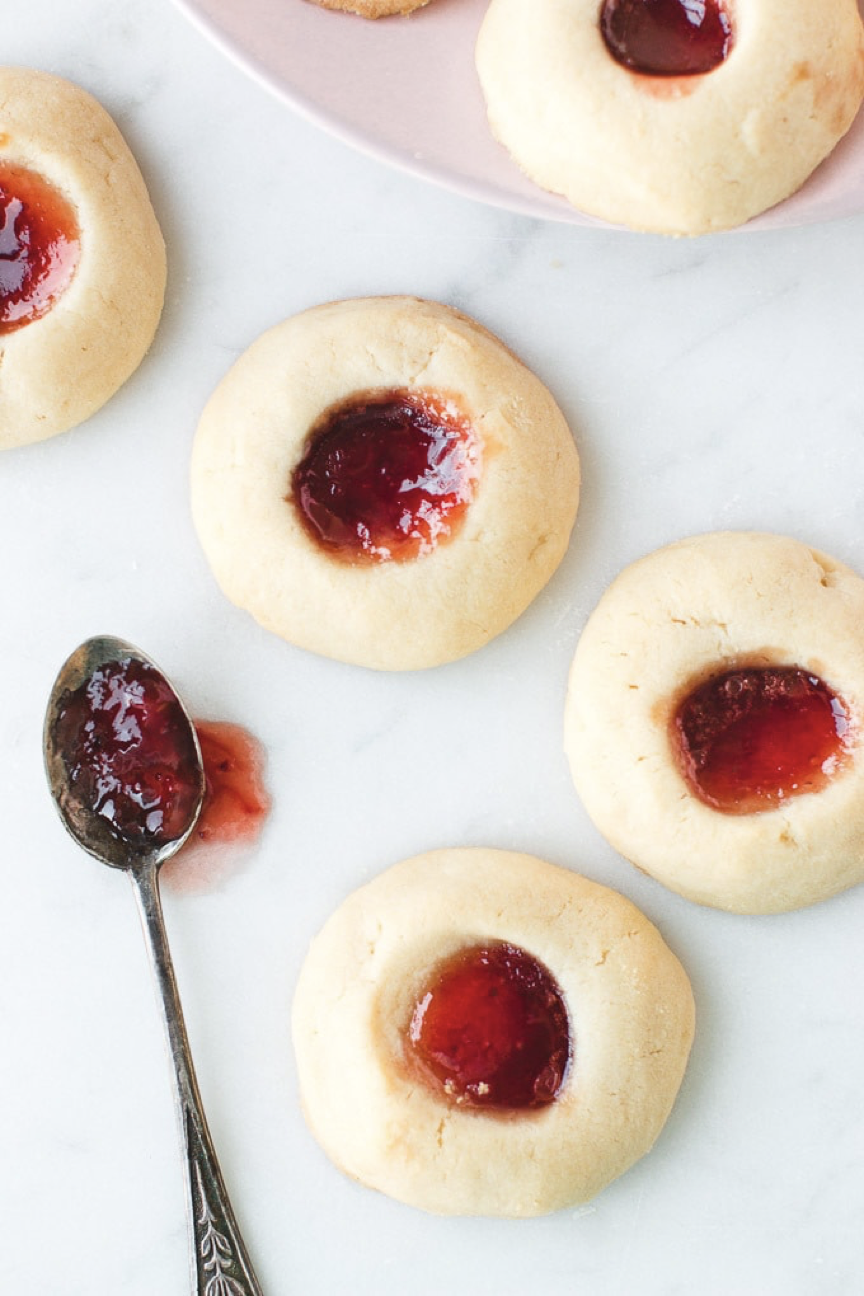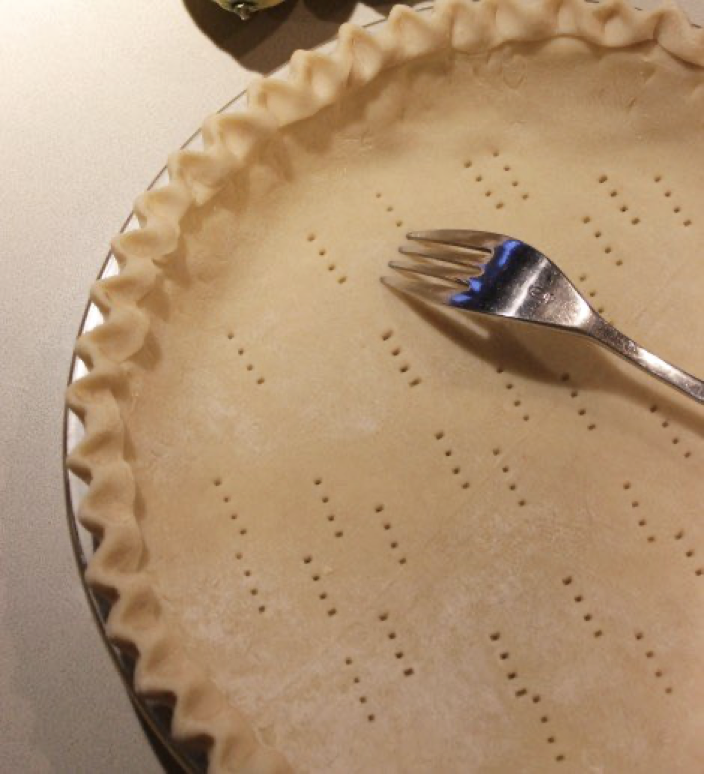Smarter and Better Baking Ideas!
Aunt Annie loved cooking and collecting cooking tips. She especially liked the tips that one of her favorite magazines, COOK’S COUNRY, shared. Here are two good ideas from one of her issues that I’ve been using for a long time:
First, you can simplify making Thumbprint Cookies. Instead of applying the dollops of jam with two spoons (such a messy and time-consuming approach), fill your turkey baster with jam. Squeezing the bulb quickly allows you to neatly squirt just the right amount of jam onto your cookies.

Next, make blind-baking a pie crust easier. Blind baking is baking an unfilled pie shell to produce a partially- or fully-baked crust (banana and coconut cream pies call for this crust, for instance). This technique prevents the crust from becoming soggy from custard based fillings, and is necessary for pies which have the fillings either cooked separately or not at all (quiche is another example).
The typical blind-bake-approach is to prick a few holes in the crust once it’s in the pan (this is called "docking"). While docking seems easy enough, it tends to create a crust that allows some of the filling to seep into and under the holes. So docking isn’t the preferred method for blind baking.

The other method is to fill the unbaked pie crust with pie weights (do one or the other; if you fill it with weights, you don't need to dock). Then you bake it until browned (or just for several minutes if your goal is a partially-baked crust).
Since the pie weight technique is best, you might consider this: Instead of lining your unbaked pie crust with aluminum foil, use a disposable aluminum pie plate instead. Fill it with pie weights (or sugar if you don’t have weights) and set it inside the crust to be baked, then bake the crust as usual. This works beautifully and you can reuse the “disposable” pie plate over and over for this.
One more smart and better baking tip from former Monthly Cook’n author, Jeanne Wolfley: When baking brownies, bars, and sheet cakes, line your baking pan with heavy-duty aluminum foil first. Spray it well with cooking spray. (Me: I like to sprinkle a good layer of sugar on top of the spray, as opposed to coating the oil with flour.) Then add your batter. Spread to all corners and sides and bake as usual.

Cool the product on a cooling rack, and when completely cool, lift the entire thing out of the pan and onto a large cutting board. Spread the foil out, away from the baked product and ice the bars or cake, and cut into squares. This process eliminates that stressful and messy step of trying to get that first square out of the pan (without crumbling, etc.), and usually eliminates washing the pan!
And finally, for the ultimate in smart and better baking, take a few minutes to download the FREE and best ebook ever, Dennis Weaver’s “How to Bake: The Art and Science of Baking”. Dennis is the baker supreme and founder/owner of The Prepared Pantry, a wonderful online all-things-cooking-and-baking site.

This is no infomercial—just a solid recommendation from a long-time fan of The Prepared Pantry. There’s no remuneration whatsoever in it for me when I applaud this 318 page book. I just love how it explains so simply the art and science behind great baking. You’ll also get kitchen-tested recipes, tips, and photos. And it offers culinary school information—stuff we ought to know but don’t, because we don’t know enough to ask!
This is the time of year we like to bake, and tend to do more of it. So, try these ideas and spend this upcoming holiday season enjoying smarter and better baking!
First, you can simplify making Thumbprint Cookies. Instead of applying the dollops of jam with two spoons (such a messy and time-consuming approach), fill your turkey baster with jam. Squeezing the bulb quickly allows you to neatly squirt just the right amount of jam onto your cookies.

Next, make blind-baking a pie crust easier. Blind baking is baking an unfilled pie shell to produce a partially- or fully-baked crust (banana and coconut cream pies call for this crust, for instance). This technique prevents the crust from becoming soggy from custard based fillings, and is necessary for pies which have the fillings either cooked separately or not at all (quiche is another example).
The typical blind-bake-approach is to prick a few holes in the crust once it’s in the pan (this is called "docking"). While docking seems easy enough, it tends to create a crust that allows some of the filling to seep into and under the holes. So docking isn’t the preferred method for blind baking.

The other method is to fill the unbaked pie crust with pie weights (do one or the other; if you fill it with weights, you don't need to dock). Then you bake it until browned (or just for several minutes if your goal is a partially-baked crust).
Since the pie weight technique is best, you might consider this: Instead of lining your unbaked pie crust with aluminum foil, use a disposable aluminum pie plate instead. Fill it with pie weights (or sugar if you don’t have weights) and set it inside the crust to be baked, then bake the crust as usual. This works beautifully and you can reuse the “disposable” pie plate over and over for this.
One more smart and better baking tip from former Monthly Cook’n author, Jeanne Wolfley: When baking brownies, bars, and sheet cakes, line your baking pan with heavy-duty aluminum foil first. Spray it well with cooking spray. (Me: I like to sprinkle a good layer of sugar on top of the spray, as opposed to coating the oil with flour.) Then add your batter. Spread to all corners and sides and bake as usual.

Cool the product on a cooling rack, and when completely cool, lift the entire thing out of the pan and onto a large cutting board. Spread the foil out, away from the baked product and ice the bars or cake, and cut into squares. This process eliminates that stressful and messy step of trying to get that first square out of the pan (without crumbling, etc.), and usually eliminates washing the pan!
And finally, for the ultimate in smart and better baking, take a few minutes to download the FREE and best ebook ever, Dennis Weaver’s “How to Bake: The Art and Science of Baking”. Dennis is the baker supreme and founder/owner of The Prepared Pantry, a wonderful online all-things-cooking-and-baking site.

This is no infomercial—just a solid recommendation from a long-time fan of The Prepared Pantry. There’s no remuneration whatsoever in it for me when I applaud this 318 page book. I just love how it explains so simply the art and science behind great baking. You’ll also get kitchen-tested recipes, tips, and photos. And it offers culinary school information—stuff we ought to know but don’t, because we don’t know enough to ask!
This is the time of year we like to bake, and tend to do more of it. So, try these ideas and spend this upcoming holiday season enjoying smarter and better baking!
Sources:
- www.prettysimplesweet.com
- www.grandcentralbakery.com
- www.davidlebovitz.com
- www.milled.com
 Alice Osborne
Alice Osborne
Weekly Newsletter Contributor since 2006
Email the author! alice@dvo.com
